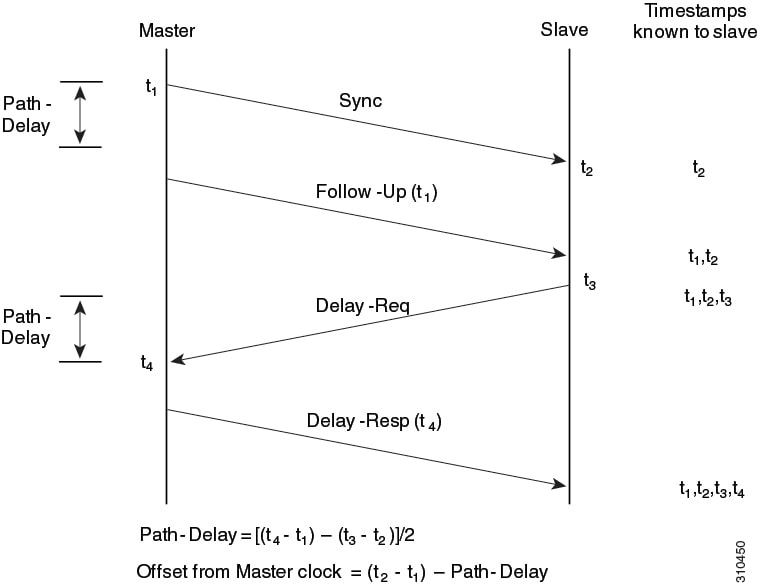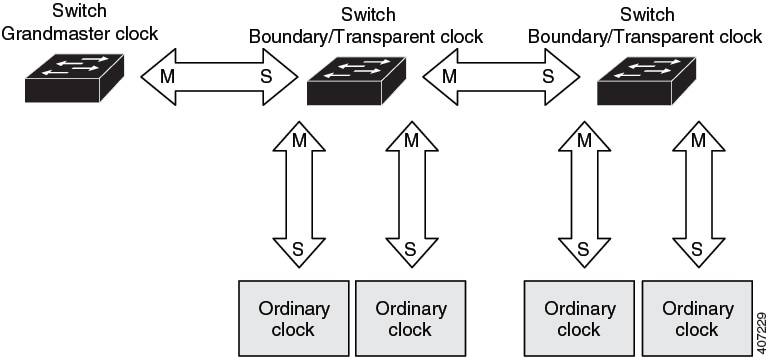Verifying Layer 2 and Layer 3 PTP Configurations
show ptp port
interface-name
To verify PTP port state, use show ptp port
interface-name command.
To verify the PTP port states on all interfaces use show ptp brief command.
The following is a sample output for boundary mode configuration with delay request mechanism:
Device# show ptp port GigabitEthernet1/0/45
PTP PORT DATASET: GigabitEthernet1/0/45
Port identity: clock identity: 0xCC:46:D6:FF:FE:C5:24:0
Port identity: port number: 45
PTP version: 2
Port state: SLAVE
Delay request interval(log mean): 0
Announce receipt time out: 3
Announce interval(log mean): 1
Sync interval(log mean): 0
Delay Mechanism: End to End
Peer delay request interval(log mean): 0
Sync fault limit: 500000000
The following is a sample output for boundary mode configuration with pdelay request mechanism:
Device# show ptp port GigabitEthernet1/0/45
PTP PORT DATASET: GigabitEthernet1/0/45
Port identity: clock identity: 0xCC:46:D6:FF:FE:C5:24:0
Port identity: port number: 45
PTP version: 2
Port state: MASTER
Delay request interval(log mean): 0
Announce receipt time out: 3
Announce interval(log mean): 1
Sync interval(log mean): 0
Delay Mechanism: Peer to Peer
Peer delay request interval(log mean): 0
Sync fault limit: 500000000
show ptp brief
To verify the PTP port states on all interfaces use show ptp brief command.
The following is a sample output for show ptp brief command:
Device# show ptp brief
Interface Domain PTP State
TenGigabitEthernet1/0/1 0 MASTER
TenGigabitEthernet1/0/2 0 SLAVE
TenGigabitEthernet1/0/3 0 FAULTY
show ptp clock
To verify the PTP clock identity details and to verify the configured values of Priority1 and Priority2, use show ptp clock command.
The following is a sample output for show ptp clock command:
Device# show ptp clock
PTP CLOCK INFO
PTP Device Type: Boundary clock
PTP Device Profile: Default Profile
Clock Identity: 0xCC:46:D6:FF:FE:C5:24:0 <<clock identity of this switch>>
Clock Domain: 0
Number of PTP ports: 52
Priority1: 128
Priority2: 128
Clock Quality:
Class: 248
Accuracy: Unknown
Offset (log variance): 16640
Offset From Master(ns): 0
Mean Path Delay(ns): 0
Steps Removed: 1
show ptp parent
To identify which Grandmaster Clock identity the device is synced to in boundary mode, use show ptp parent command.

Note
|
show ptp parent will not display any output if the device is configured in transparent clock mode.
|
The following is a sample output for show ptp parent command:
Device# show ptp parent
PTP PARENT PROPERTIES
Parent Clock:
Parent Clock Identity: 0x0:11:1:FF:FE:0:0:1
Parent Port Number: 1
Observed Parent Offset (log variance): 16640
Observed Parent Clock Phase Change Rate: N/A
Grandmaster Clock:
Grandmaster Clock Identity: 0x0:11:1:FF:FE:0:0:1 <<Grandmaster clock identity to which the device is synced to>>
Grandmaster Clock Quality:
Class: 6
Accuracy: Within 25ns
Offset (log variance): 0
Priority1: 128
Priority2: 128
show platform software fed active ptp domain 0
To verify the local servo PTP clock synchronization to Grandmaster clock on a device configured in boundary mode with delay-request
mechanism, use show platform software fed active ptp domain 0 command.
Device#
show platform software fed active ptp domain 0
Displaying data for domain number 0
============================
Profile Type : DEFAULT
Profile State: enabled
Clock Mode : BOUNDARY CLOCK
Delay mechanism: End-to-End
PTP clock : 2017-6-28 5:58:59
Transport Method: L2 Ethernet
By default, local servo PTP clock will be displaying EPOCH time(1970-1-1) when the device is not synced to any PTP Grandmaster
Clock.
show ptp port
interface-name
To verify PTP port state, use show ptp port
interface-name command.
To verify the PTP port states on all interfaces use show ptp brief command.
The following is a sample output for boundary mode configuration with delay request mechanism:
Device# show ptp port FortyGigabitEthernet1/0/10
PTP PORT DATASET: FortyGigabitEthernet1/0/10
Port identity: clock identity: 0x0:A3:D1:FF:FE:5A:12:0
Port identity: port number: 10
PTP version: 2
Port state: SLAVE
Delay request interval(log mean): 0
Announce receipt time out: 3
Announce interval(log mean): 1
Sync interval(log mean): 0
Delay Mechanism: End to End << PTP mode delay >>
Peer delay request interval(log mean): 0
Sync fault limit: 500000000
show ptp parent
To identify which Grandmaster Clock identity the device is synced to in boundary mode, use show ptp parent command.

Note
|
show ptp parent will not display any output if the device is configured in transparent clock mode.
|
The following is a sample output for show ptp parent command:
Device# show ptp parent
PTP PARENT PROPERTIES
Parent Clock:
Parent Clock Identity: 0x38:E:4D:FF:FE:81:FE:29 << Immediate next Master >>
Parent Port Number: 196
Observed Parent Offset (log variance): 17258
Observed Parent Clock Phase Change Rate: N/A
Grandmaster Clock:
Grandmaster Clock Identity: 0x0:0:0:5:0:0:0:1 << GM: External Clock Source acting Grand Master >>
Grandmaster Clock Quality:
Class: 6
Accuracy: Within 1us
Offset (log variance): 0
Priority1: 128
Priority2: 128
show platform software fed active ptp domain 0
To verify the local servo PTP clock synchronization to Grandmaster clock on a device configured in boundary mode with delay-request
mechanism, use show platform software fed active ptp domain 0 command.
Device#
show platform software fed active ptp domain 0
Displaying data for domain number 0
=======================================
Profile Type : DEFAULT
Profile State: enabled
Clock Mode : BOUNDARY CLOCK
Delay Mechanism: : END-TO-END
PTP clock : 2017-12-15 15:27:27
mean_path_delay 214 nanoseconds
Transport Method : udp-ipv4 << PTP Transport Method >>
Verifying PTP Configurations on an EtherChannel Interface
Master Clock
The following command verifies the PTP state on an interface:
Device# show ptp port tengigabitethernet 1/0/39
PTP PORT DATASET: TenGigE1/0/39
Port identity: clock identity: 0x0:A7:42:FF:FE:8A:84:C0
Port identity: port number: 39
PTP version: 2
Port state: MASTER
Delay request interval(log mean): 0
Announce receipt time out: 3
Announce interval(log mean): 0
Sync interval(log mean): 0
Delay Mechanism: End to End
Peer delay request interval(log mean): 0
Sync fault limit: 500000000
Device# show ptp port tengigabitethernet 1/0/44
PTP PORT DATASET: TenGigE1/0/44
Port identity: clock identity: 0x0:A7:42:FF:FE:8A:84:C0
Port identity: port number: 44
PTP version: 2
Port state: MASTER
Delay request interval(log mean): 0
Announce receipt time out: 3
Announce interval(log mean): 0
Sync interval(log mean): 0
Delay Mechanism: End to End
Peer delay request interval(log mean): 0
Sync fault limit: 500000000
Device# show ptp port tengigabitethernet 1/0/48
PTP PORT DATASET: TenGigE1/0/48
Port identity: clock identity: 0x0:A7:42:FF:FE:8A:84:C0
Port identity: port number: 48
PTP version: 2
Port state: MASTER
Delay request interval(log mean): 0
Announce receipt time out: 3
Announce interval(log mean): 0
Sync interval(log mean): 0
Delay Mechanism: End to End
Peer delay request interval(log mean): 0
Sync fault limit: 500000000
Slave Clock
The following command can be used to verify the PTP state on the interfaces:
Device# show ptp brief | exclude FAULTY
Interface Domain PTP State
tenGigE1/0/12 0 SLAVE
TenGigE1/0/20 0 PASSIVE
TenGigE1/0/23 0 PASSIVE
The following command verifies if interface configured on each port is an EtherChannel interface:
Device# show etherchannel 1 summary
Flags: D - down P - bundled in port-channel
I - stand-alone s - suspended
H - Hot-standby (LACP only)
R - Layer3 S - Layer2
U - in use f - failed to allocate aggregator
M - not in use, minimum links not met
u - unsuitable for bundling
w - waiting to be aggregated
d - default port
A - formed by Auto LAG
Number of channel-groups in use: 1
Number of aggregators: 1
Group Port-channel Protocol Ports
------+-------------+-----------+-----------------------------------------------
1 Po1(SU) LACP Hu1/0/12(P) Hu1/0/20(P)
Hu1/0/23(P)
The following command verifies port state of each interface:
Device# show ptp port tengigabitethernet 1/0/12
PTP PORT DATASET: TenGigE1/0/12
Port identity: clock identity: 0x0:A7:42:FF:FE:9B:DA:E0
Port identity: port number: 12
PTP version: 2
PTP port number: 12
PTP slot number: 0
Port state: SLAVE
Delay request interval(log mean): 0
Announce receipt time out: 3
Announce interval(log mean): 0
Sync interval(log mean): 0
Delay Mechanism: End to End
Peer delay request interval(log mean): 0
Sync fault limit: 500000000
Device# show ptp port tengigabitethernet 1/0/20
PTP PORT DATASET: TenGigE1/0/20
Port identity: clock identity: 0x0:A7:42:FF:FE:9B:DA:E0
Port identity: port number: 20
PTP version: 2
PTP port number: 20
PTP slot number: 0
Port state: PASSIVE
Delay request interval(log mean): 0
Announce receipt time out: 3
Announce interval(log mean): 0
Sync interval(log mean): 0
Delay Mechanism: End to End
Peer delay request interval(log mean): 0
Sync fault limit: 500000000
Device# show ptp port tengigabitethernet 1/0/23
PTP PORT DATASET: TenGigE1/0/23
Port identity: clock identity: 0x0:A7:42:FF:FE:9B:DA:E0
Port identity: port number: 23
PTP version: 2
PTP port number: 23
PTP slot number: 0
Port state: PASSIVE
Delay request interval(log mean): 0
Announce receipt time out: 3
Announce interval(log mean): 0
Sync interval(log mean): 0
Delay Mechanism: End to End
Peer delay request interval(log mean): 0
Sync fault limit: 500000000








 Feedback
Feedback